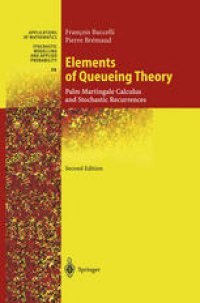
Ebook: Elements of Queueing Theory: Palm Martingale Calculus and Stochastic Recurrences
- Tags: Probability Theory and Stochastic Processes, Statistical Theory and Methods, Communications Engineering Networks, Economic Theory
- Series: Applications of Mathematics 26
- Year: 2003
- Publisher: Springer-Verlag Berlin Heidelberg
- Edition: 2
- Language: English
- pdf
The Palm theory and the Loynes theory of stationary systems are the two pillars of the modern approach to queuing. This book, presenting the mathematical foundations of the theory of stationary queuing systems, contains a thorough treatment of both of these.
This approach helps to clarify the picture, in that it separates the task of obtaining the key system formulas from that of proving convergence to a stationary state and computing its law.
The theory is constantly illustrated by classical results and models: Pollaczek-Khintchin and Tacacs formulas, Jackson and Gordon-Newell networks, multiserver queues, blocking queues, loss systems etc., but it also contains recent and significant examples, where the tools developed turn out to be indispensable.
Several other mathematical tools which are useful within this approach are also presented, such as the martingale calculus for point processes, or stochastic ordering for stationary recurrences.
This thoroughly revised second edition contains substantial additions - in particular, exercises and their solutions - rendering this now classic reference suitable for use as a textbook.
The Palm theory and the Loynes theory of stationary systems are the two pillars of the modern approach to queuing. This book, presenting the mathematical foundations of the theory of stationary queuing systems, contains a thorough treatment of both of these.
This approach helps to clarify the picture, in that it separates the task of obtaining the key system formulas from that of proving convergence to a stationary state and computing its law.
The theory is constantly illustrated by classical results and models: Pollaczek-Khintchin and Tacacs formulas, Jackson and Gordon-Newell networks, multiserver queues, blocking queues, loss systems etc., but it also contains recent and significant examples, where the tools developed turn out to be indispensable.
Several other mathematical tools which are useful within this approach are also presented, such as the martingale calculus for point processes, or stochastic ordering for stationary recurrences.
This thoroughly revised second edition contains substantial additions - in particular, exercises and their solutions - rendering this now classic reference suitable for use as a textbook.